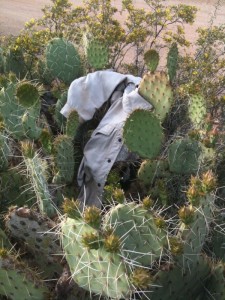
Sometimes a place can imprint you with its own tragedy. Maybe that was the idea behind the supposed hauntings last week.
Right now I’m a bit imprinted by the day I spent with the dusk shift of the Tohonoh O’odham Reservation Police Department, during which time I toured much of their 75 miles of border with Mexico. I heard a lot of terrible stories—dogs bringing skeletal bones into the kitchens of tribal members, the way the corpses found in the desert bloat in summer and stay fresh in winter. But the worst, of course, was about the children. Not that any of them have been found dead of late on the reservation. But plenty have been found live, and abandoned.
“It happens because they don’t cross with a mom or a dad, just a cousin or an uncle,” was the way the female patrol sergeant who was with me tried to explain the unexplainable. “So when we happen on them, the groups scatter. That bond isn’t there. And they leave the children behind.”
Ranchers out in southeast Arizona had also been telling me they’ve been finding more diapers in the desert, among with all the knapsacks and bedrolls that the human coyotes and their migrants leave behind. Who brings a baby into this land, they asked?
Good fucking question.
That’s the part I still don’t get: Do the migrants simply not know how dangerous and forbidding the landscape on this side of the border is? Do they not know how mesquite branches can tear your clothes and draw blood; how the blister beetles will leave you with open sores; how the snakes don’t look for trouble, but will easily bite when startled?
Or maybe they do know, but they’re so desperate they cross anyway, and just hope that they make it. That’s what really scary, that kind of desperation. Making it with the children would be, apparently, just an added bonus.

That’s a good question. On the other hand, in my visits to high-emigration towns in Mexico, I always wondered what kind of parents would leave their kids behind to be raised by old women and strangers. Obviously, the system is broken. Prior to 1994’s big buildup of the Border Patrol in an effort to deter crossing, migration from Mexico was in large part circular and seasonal. For every 100 that came, 85 would leave. After we made it much more difficult to cross back and forth, men would come and stay, then they would send for their families. We need to reform and manage the system in a way that recognizes economic realities so that those who take the seasonal and shit jobs no one here wants to do can, and we need to make legal immigration less impossible.
By the way, many of the migrants in fact have no idea what they’re in for. I’ve met teens who were lied to by the coyotes that it’s just a half-day, easy trek. I’ve seen elaborate cowboy boots on corpses of young men from Michoacan; boots that no one walking through a desert should be wearing. Beside them a single milk jug for water, empty.
Those are intense stories, NP. I’ve heard of some of that from migrants in Mexico and the U.S., but always as second-hand stories. I hope you tell everyone you know–family, friends, those teen girls on MySpace–to get the word out: there’s not a lot of real information out there, from people who actually know what they’re talking about.